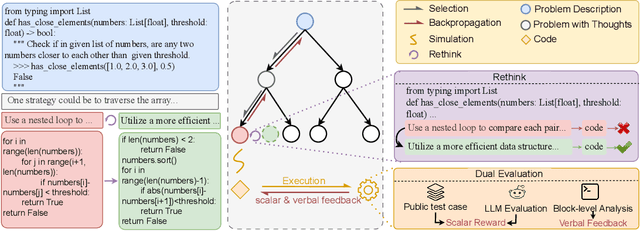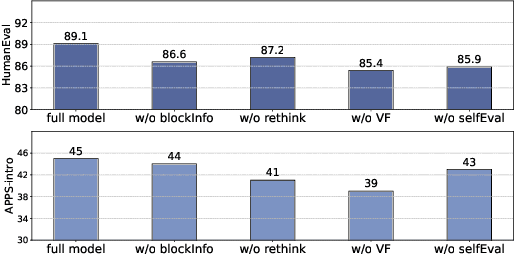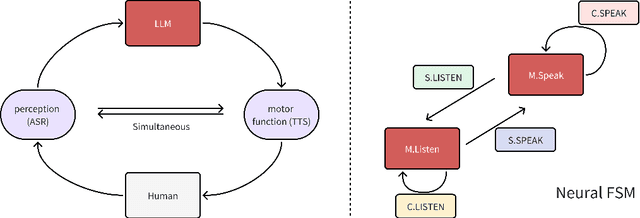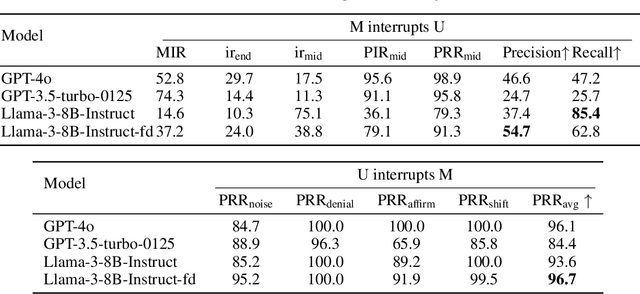Wei Xia
AdvKT: An Adversarial Multi-Step Training Framework for Knowledge Tracing
Apr 07, 2025Abstract:Knowledge Tracing (KT) monitors students' knowledge states and simulates their responses to question sequences. Existing KT models typically follow a single-step training paradigm, which leads to discrepancies with the multi-step inference process required in real-world simulations, resulting in significant error accumulation. This accumulation of error, coupled with the issue of data sparsity, can substantially degrade the performance of recommendation models in the intelligent tutoring systems. To address these challenges, we propose a novel Adversarial Multi-Step Training Framework for Knowledge Tracing (AdvKT), which, for the first time, focuses on the multi-step KT task. More specifically, AdvKT leverages adversarial learning paradigm involving a generator and a discriminator. The generator mimics high-reward responses, effectively reducing error accumulation across multiple steps, while the discriminator provides feedback to generate synthetic data. Additionally, we design specialized data augmentation techniques to enrich the training data with realistic variations, ensuring that the model generalizes well even in scenarios with sparse data. Experiments conducted on four real-world datasets demonstrate the superiority of AdvKT over existing KT models, showcasing its ability to address both error accumulation and data sparsity issues effectively.
Expansion Span: Combining Fading Memory and Retrieval in Hybrid State Space Models
Dec 17, 2024



Abstract:The "state" of State Space Models (SSMs) represents their memory, which fades exponentially over an unbounded span. By contrast, Attention-based models have "eidetic" (i.e., verbatim, or photographic) memory over a finite span (context size). Hybrid architectures combine State Space layers with Attention, but still cannot recall the distant past and can access only the most recent tokens eidetically. Unlike current methods of combining SSM and Attention layers, we allow the state to be allocated based on relevancy rather than recency. In this way, for every new set of query tokens, our models can "eidetically" access tokens from beyond the Attention span of current Hybrid SSMs without requiring extra hardware resources. We describe a method to expand the memory span of the hybrid state by "reserving" a fraction of the Attention context for tokens retrieved from arbitrarily distant in the past, thus expanding the eidetic memory span of the overall state. We call this reserved fraction of tokens the "expansion span," and the mechanism to retrieve and aggregate it "Span-Expanded Attention" (SE-Attn). To adapt Hybrid models to using SE-Attn, we propose a novel fine-tuning method that extends LoRA to Hybrid models (HyLoRA) and allows efficient adaptation on long spans of tokens. We show that SE-Attn enables us to efficiently adapt pre-trained Hybrid models on sequences of tokens up to 8 times longer than the ones used for pre-training. We show that HyLoRA with SE-Attn is cheaper and more performant than alternatives like LongLoRA when applied to Hybrid models on natural language benchmarks with long-range dependencies, such as PG-19, RULER, and other common natural language downstream tasks.
Self-Supervised Graph Embedding Clustering
Sep 24, 2024



Abstract:The K-means one-step dimensionality reduction clustering method has made some progress in addressing the curse of dimensionality in clustering tasks. However, it combines the K-means clustering and dimensionality reduction processes for optimization, leading to limitations in the clustering effect due to the introduced hyperparameters and the initialization of clustering centers. Moreover, maintaining class balance during clustering remains challenging. To overcome these issues, we propose a unified framework that integrates manifold learning with K-means, resulting in the self-supervised graph embedding framework. Specifically, we establish a connection between K-means and the manifold structure, allowing us to perform K-means without explicitly defining centroids. Additionally, we use this centroid-free K-means to generate labels in low-dimensional space and subsequently utilize the label information to determine the similarity between samples. This approach ensures consistency between the manifold structure and the labels. Our model effectively achieves one-step clustering without the need for redundant balancing hyperparameters. Notably, we have discovered that maximizing the $\ell_{2,1}$-norm naturally maintains class balance during clustering, a result that we have theoretically proven. Finally, experiments on multiple datasets demonstrate that the clustering results of Our-LPP and Our-MFA exhibit excellent and reliable performance.
RethinkMCTS: Refining Erroneous Thoughts in Monte Carlo Tree Search for Code Generation
Sep 15, 2024



Abstract:LLM agents enhanced by tree search algorithms have yielded notable performances in code generation. However, current search algorithms in this domain suffer from low search quality due to several reasons: 1) Ineffective design of the search space for the high-reasoning demands of code generation tasks, 2) Inadequate integration of code feedback with the search algorithm, and 3) Poor handling of negative feedback during the search, leading to reduced search efficiency and quality. To address these challenges, we propose to search for the reasoning process of the code and use the detailed feedback of code execution to refine erroneous thoughts during the search. In this paper, we introduce RethinkMCTS, which employs the Monte Carlo Tree Search (MCTS) algorithm to conduct thought-level searches before generating code, thereby exploring a wider range of strategies. More importantly, we construct verbal feedback from fine-grained code execution feedback to refine erroneous thoughts during the search. This ensures that the search progresses along the correct reasoning paths, thus improving the overall search quality of the tree by leveraging execution feedback. Through extensive experiments, we demonstrate that RethinkMCTS outperforms previous search-based and feedback-based code generation baselines. On the HumanEval dataset, it improves the pass@1 of GPT-3.5-turbo from 70.12 to 89.02 and GPT-4o-mini from 87.20 to 94.51. It effectively conducts more thorough exploration through thought-level searches and enhances the search quality of the entire tree by incorporating rethink operation.
DetoxBench: Benchmarking Large Language Models for Multitask Fraud & Abuse Detection
Sep 09, 2024Abstract:Large language models (LLMs) have demonstrated remarkable capabilities in natural language processing tasks. However, their practical application in high-stake domains, such as fraud and abuse detection, remains an area that requires further exploration. The existing applications often narrowly focus on specific tasks like toxicity or hate speech detection. In this paper, we present a comprehensive benchmark suite designed to assess the performance of LLMs in identifying and mitigating fraudulent and abusive language across various real-world scenarios. Our benchmark encompasses a diverse set of tasks, including detecting spam emails, hate speech, misogynistic language, and more. We evaluated several state-of-the-art LLMs, including models from Anthropic, Mistral AI, and the AI21 family, to provide a comprehensive assessment of their capabilities in this critical domain. The results indicate that while LLMs exhibit proficient baseline performance in individual fraud and abuse detection tasks, their performance varies considerably across tasks, particularly struggling with tasks that demand nuanced pragmatic reasoning, such as identifying diverse forms of misogynistic language. These findings have important implications for the responsible development and deployment of LLMs in high-risk applications. Our benchmark suite can serve as a tool for researchers and practitioners to systematically evaluate LLMs for multi-task fraud detection and drive the creation of more robust, trustworthy, and ethically-aligned systems for fraud and abuse detection.
* 12 pages
MBA-Net: SAM-driven Bidirectional Aggregation Network for Ovarian Tumor Segmentation
Jul 08, 2024



Abstract:Accurate segmentation of ovarian tumors from medical images is crucial for early diagnosis, treatment planning, and patient management. However, the diverse morphological characteristics and heterogeneous appearances of ovarian tumors pose significant challenges to automated segmentation methods. In this paper, we propose MBA-Net, a novel architecture that integrates the powerful segmentation capabilities of the Segment Anything Model (SAM) with domain-specific knowledge for accurate and robust ovarian tumor segmentation. MBA-Net employs a hybrid encoder architecture, where the encoder consists of a prior branch, which inherits the SAM encoder to capture robust segmentation priors, and a domain branch, specifically designed to extract domain-specific features. The bidirectional flow of information between the two branches is facilitated by the robust feature injection network (RFIN) and the domain knowledge integration network (DKIN), enabling MBA-Net to leverage the complementary strengths of both branches. We extensively evaluate MBA-Net on the public multi-modality ovarian tumor ultrasound dataset and the in-house multi-site ovarian tumor MRI dataset. Our proposed method consistently outperforms state-of-the-art segmentation approaches. Moreover, MBA-Net demonstrates superior generalization capability across different imaging modalities and clinical sites.
CoIR: A Comprehensive Benchmark for Code Information Retrieval Models
Jul 03, 2024Abstract:Despite the substantial success of Information Retrieval (IR) in various NLP tasks, most IR systems predominantly handle queries and corpora in natural language, neglecting the domain of code retrieval. Code retrieval is critically important yet remains under-explored, with existing methods and benchmarks inadequately representing the diversity of code in various domains and tasks. Addressing this gap, we present \textbf{\name} (\textbf{Co}de \textbf{I}nformation \textbf{R}etrieval Benchmark), a robust and comprehensive benchmark specifically designed to assess code retrieval capabilities. \name comprises \textbf{ten} meticulously curated code datasets, spanning \textbf{eight} distinctive retrieval tasks across \textbf{seven} diverse domains. We first discuss the construction of \name and its diverse dataset composition. Further, we evaluate nine widely used retrieval models using \name, uncovering significant difficulties in performing code retrieval tasks even with state-of-the-art systems. To facilitate easy adoption and integration within existing research workflows, \name has been developed as a user-friendly Python framework, readily installable via pip. It shares same data schema as other popular benchmarks like MTEB and BEIR, enabling seamless cross-benchmark evaluations. Through \name, we aim to invigorate research in the code retrieval domain, providing a versatile benchmarking tool that encourages further development and exploration of code retrieval systems\footnote{\url{ https://github.com/CoIR-team/coir}}.
SINKT: A Structure-Aware Inductive Knowledge Tracing Model with Large Language Model
Jul 01, 2024



Abstract:Knowledge Tracing (KT) aims to determine whether students will respond correctly to the next question, which is a crucial task in intelligent tutoring systems (ITS). In educational KT scenarios, transductive ID-based methods often face severe data sparsity and cold start problems, where interactions between individual students and questions are sparse, and new questions and concepts consistently arrive in the database. In addition, existing KT models only implicitly consider the correlation between concepts and questions, lacking direct modeling of the more complex relationships in the heterogeneous graph of concepts and questions. In this paper, we propose a Structure-aware Inductive Knowledge Tracing model with large language model (dubbed SINKT), which, for the first time, introduces large language models (LLMs) and realizes inductive knowledge tracing. Firstly, SINKT utilizes LLMs to introduce structural relationships between concepts and constructs a heterogeneous graph for concepts and questions. Secondly, by encoding concepts and questions with LLMs, SINKT incorporates semantic information to aid prediction. Finally, SINKT predicts the student's response to the target question by interacting with the student's knowledge state and the question representation. Experiments on four real-world datasets demonstrate that SINKT achieves state-of-the-art performance among 12 existing transductive KT models. Additionally, we explore the performance of SINKT on the inductive KT task and provide insights into various modules.
A Full-duplex Speech Dialogue Scheme Based On Large Language Models
May 29, 2024



Abstract:We present a generative dialogue system capable of operating in a full-duplex manner, allowing for seamless interaction. It is based on a large language model (LLM) carefully aligned to be aware of a perception module, a motor function module, and the concept of a simple finite state machine (called neural FSM) with two states. The perception and motor function modules operate simultaneously, allowing the system to simultaneously speak and listen to the user. The LLM generates textual tokens for inquiry responses and makes autonomous decisions to start responding to, wait for, or interrupt the user by emitting control tokens to the neural FSM. All these tasks of the LLM are carried out as next token prediction on a serialized view of the dialogue in real-time. In automatic quality evaluations simulating real-life interaction, the proposed system reduces the average conversation response latency by more than 3 folds compared with LLM-based half-duplex dialogue systems while responding within less than 500 milliseconds in more than 50% of evaluated interactions. Running a LLM with only 8 billion parameters, our system exhibits a 8% higher interruption precision rate than the best available commercial LLM for voice-based dialogue.
Learning Structure and Knowledge Aware Representation with Large Language Models for Concept Recommendation
May 21, 2024



Abstract:Concept recommendation aims to suggest the next concept for learners to study based on their knowledge states and the human knowledge system. While knowledge states can be predicted using knowledge tracing models, previous approaches have not effectively integrated the human knowledge system into the process of designing these educational models. In the era of rapidly evolving Large Language Models (LLMs), many fields have begun using LLMs to generate and encode text, introducing external knowledge. However, integrating LLMs into concept recommendation presents two urgent challenges: 1) How to construct text for concepts that effectively incorporate the human knowledge system? 2) How to adapt non-smooth, anisotropic text encodings effectively for concept recommendation? In this paper, we propose a novel Structure and Knowledge Aware Representation learning framework for concept Recommendation (SKarREC). We leverage factual knowledge from LLMs as well as the precedence and succession relationships between concepts obtained from the knowledge graph to construct textual representations of concepts. Furthermore, we propose a graph-based adapter to adapt anisotropic text embeddings to the concept recommendation task. This adapter is pre-trained through contrastive learning on the knowledge graph to get a smooth and structure-aware concept representation. Then, it's fine-tuned through the recommendation task, forming a text-to-knowledge-to-recommendation adaptation pipeline, which effectively constructs a structure and knowledge-aware concept representation. Our method does a better job than previous adapters in transforming text encodings for application in concept recommendation. Extensive experiments on real-world datasets demonstrate the effectiveness of the proposed approach.
 Add to Chrome
Add to Chrome Add to Firefox
Add to Firefox Add to Edge
Add to Edge